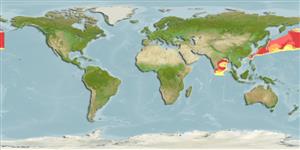Lớp phụ Cá sụn (cá mập và cá đuối) (sharks and rays) >
Squaliformes (Sleeper and dogfish sharks) >
Somniosidae (Sleeper sharks)
Etymology: Scymnodon: scymnus, an ancient name for some kind of shark, derived from a Greek word meaning young animal, cub or whelp; odon (Gr.), tooth, referring to large, triangular cutting teeth on lower jaw of S. ringens (See ETYFish); ichiharai: In honor of marine biologist (specializing in whales) Tadayoshi Ichihara (d. 1981), Tokai University (Tokyo, Japan), who suggested that the authors study this shark (See ETYFish).
Eponymy: Dr Tadayoshi Ichihara (d: 1981) was a scientist at the Whales Research Institute, Tokyo, Japan. [...] (Ref. 128868), visit book page.
More on authors: Yano & Tanaka.
Environment: milieu / climate zone / Mức độ sâu / distribution range
Sinh thái học
Biển Tầng nổi biển sâu; Mức độ sâu 400 - 830 m (Ref. 131163). Deep-water
Indo-West Pacific: Andaman Is., Japan and Taiwan.
Bộ gần gũi / Khối lượng (Trọng lượng) / Age
Chín muồi sinh dục: Lm ? range ? - ? cm
Max length : 101 cm TL con đực/không giới tính; (Ref. 131163); 151.1 cm TL (female)
Short description
Khóa để định loại | Hình thái học | Sinh trắc học
This large brownish-black deep-water shark is distinguished by the following: body is subcylindrical; head depressed, flat above and broad; short snout; dermal denticles along the trunk with pedicelated crowns, supporting dorsal leaf-like blades, with posterior margin of blade straight, slightly undulated, or serrated; only oblique cusps on the lower jaw teeth, without any symmetrical symphysial tooth and outer margin of main cusp almost erect; first and second dorsal fin with a small exposed spine; narrow paddle-shaped pectoral fin (pectoral fin posterior margin 4.6-6.9 % TL); pelvic fin about equal to the second dorsal fin; deep caudal fin, forked barely, with apex of the upper lobe moderately rounded; no anal fin; eyes and spiracle large; upper teeth much smaller than lower, distinct as small spear-like smooth edges in upper teeth and lower triangular (Ref. 125648, 131163).
Cross section: oval.
The smallest recorded mature male is 89.2 cm TL; smallest juvenile male 49.2 cm TL; a female found pregnant with both uteri containing an undetermined number of fertilised eggs 135,1 cm TL; one immature female 105.5 cm TL and five mature females between 126.0-145.5 cm TL (Ref. 125648). Ovoviviparous (Ref. 205).
Life cycle and mating behavior
Chín muồi sinh dục | Sự tái sinh sản | Đẻ trứng | Các trứng | Sự sinh sản | Ấu trùng
Distinct pairing with embrace (Ref. 205).
Yano, K and S. Tanaka, 1984. Review of the deep sea squaloid shark genus Scymnodon of Japan, with a description of a new species. Jap. J. Ichthyol. 30(4):341-360. (Ref. 31249)
IUCN Red List Status (Ref. 130435: Version 2025-1)
Threat to humans
Harmless
Human uses
Các công cụ
Special reports
Download XML
Các nguồn internet
Estimates based on models
Phylogenetic diversity index (Tài liệu tham khảo
82804): PD
50 = 0.6250 [Uniqueness, from 0.5 = low to 2.0 = high].
Bayesian length-weight: a=0.00380 (0.00164 - 0.00880), b=3.14 (2.95 - 3.33), in cm total length, based on LWR estimates for this (Sub)family-body shape (Ref.
93245).
Mức dinh dưỡng (Tài liệu tham khảo
69278): 4.2 ±0.7 se; based on size and trophs of closest relatives
Thích nghi nhanh (Tài liệu tham khảo
120179): thấp, thời gian nhân đôi của chủng quần tối thiểu là 4.5 - 14 năm (Fec assumed to be <100).
Fishing Vulnerability (Ref.
59153): Very high vulnerability (90 of 100).
🛈
